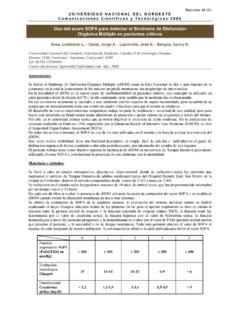Transcription of Intrahospital transport policies: The contribution of the ...
1 HHEEAALLTTHH SSCCIIEENNCCEE JJOOUURRNNAALL VOLUME 8 (2014),ISSUE 1 E-ISSN:1791-809x Published by Department of Nursing , Technological Educational Institute of Athens P a g e | 166 REVIEW ARTICLE Intrahospital transport policies : The contribution of the nurse Despoina G. Alamanou 1, Hero Brokalaki 2 1. RN, MSc, PhD(c), 2nd Internal Medicine Department, 417 Hospital of Athens, Greece 2.
2 Associate Professor, Faculty of Nursing, National and Kapodistrian University of Athens, Greece Abstract Background: Although Intrahospital transports are performed daily in hospitals, they pose various risks to patients, which could lead to life-threatening complications. Nursing care, significantly, contribute to achieve the above, although the role of the nurse has never been studied, separately. The aim of this study was to analyze the risk factors for complications that usually occur during Intrahospital transports and describe the role of nursing in Intrahospital transport policies .
3 Method and Material: We searched electronic databases Medline, Cinahl, Cochrane Library and Scirus, for the period 1980-2013, on both original articles and reviews, selecting and analyzing the articles related to the issue. Results: The risk factors for complications during Intrahospital transport are related to patient s illness severity, handling during transport , inadequate equipment, lack of highly trained staff, inadequate monitoring and ineffective communication among staff during transport .
4 Nurses have an active involvement in Intrahospital transport procedures, as personnel of the sending and receiving departments or as members of the Intrahospital transport team, following or upgrading current policy. Nurses can create an Intrahospital transport protocol, based on published guidelines, train the staff on it, assess and stabilize patient s health condition prior to transport and improve the overall quality of care for transported patients. Conclusion: The risks posed by Intrahospital transports for critically ill patients can be minimized or even prevented by a well-designed transport protocol with the effective participation of the nurse.
5 Keywords: Critically ill patients, health care, Intrahospital transport , literature review, nursing care Corresponding author: Despoina G. Alamanou, 10-12 Monis Petraki Str, 11521, Athens, Greece, Tel: 00306937509784, e-mail: Introduction The need for numerous diagnostic or interventional tests in hospitalized patients requires, even today, where technological development is rapid, and their transport into or outside the hospital. Intrahospital transport is called the transfer of patients in the hospital for diagnostic or therapeutic purposes or their transfer to specialized units of the This usually involves moving the patient from an area of the hospital such as the intensive care unit (ICU), the emergency department (ED), the operating theatre department to areas that patients may not receive the same intensive care.
6 The reduction or change of care and the movement itself can become, for the critically ill patients, the cause for serious complications and put their health at risk. In recent years, Intrahospital transports have been extensively studied and described in literature as risky procedures, especially for critically ill They are associated with increased incidence of life-threatening complications, morbidity and mortality,3 VOLUME 8 (2014),ISSUE 2 HHEEAALLTTHH SSCCIIEENNCCEE JJOOUURRNNAALL Intrahospital transport policies : The contribution of the Science.
7 8 (1) P a g e | 167 particularly for patients transported outside the ICU. The interest of researchers in the last 20 years has focused on adverse events occurring during Intrahospital transport of critically ill patients,4,5 the equipment that should accompany the critically ill during transport ,6 and on the prevention and management of these complications. Several professional organizations, including the Society of Critical Care Medicine (SCCM), the American Association of Respiratory Care, the European Society of Intensive Care Medicine (ESICM), the Study Group for Safety in Anesthesia and Intensive Care (SIAARTI), the Australasian College for Emergency Medicine and very recently the Soci t de R animation de Langue Fran aise (SRLF), the Soci t Fran aise d'Anesth sie et de R animation (SFAR)
8 , and the Soci t Fran aise de M decine d'Urgence (SFMU) have published guidelines for the performance of Intrahospital Hospitals all over the world developed Intrahospital transport policies , based on the above. However, not every hospital in all countries does follow these guidelines, due to lack of resources or highly trained personnel. Transporting a critically ill patient within the hospital creates a challenging and highly stressful work environment, even for experienced physicians and Nurses, in every day clinical practice, deal with critically ill transported patients, who need holistic nursing care and their role can be multifunctional, since they participate in almost every part of patients care having different and complex responsibilities.
9 For example, a nurse providing care in the Radiology Department must facilitate the required diagnostic testing and simultaneously provide the surveillance necessary to detect physiological changes signaling the need for intervention, like activation of a Medical Emergency Nurses, working in ICU, must provide high-quality nursing care, constant monitoring and prepare the critically ill patient for transport outside of the secure environment. Nurses working as members of the Intrahospital transport team should provide qualitative, continuing health care and vigilance for the occurrence of complications during transport .
10 In addition, as members of clinical departments in the hospital, they are also responsible for preparing and stabilizing patient before sending for transport and after admitting patient to destination department. Therefore, the assumption of these responsibilities should be undertaken by appropriately trained nurses and other personnel, because as Fanara10 poses in a study, the critically ill patients, prepared and accompanied by inappropriate personnel are a dangerous combination.












